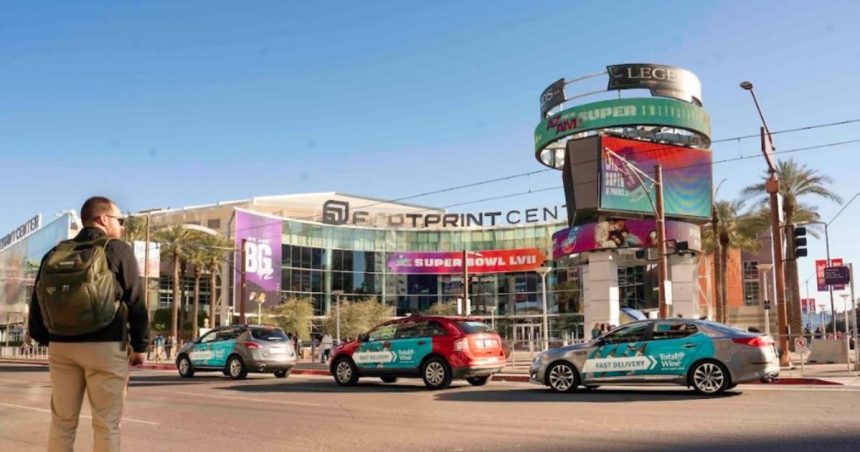Couldn’t secure a Super Bowl ad? Why not rent a car instead?
Like seemingly every other surface in the world, cars have become a popular vehicle for ads. Rideshare advertising company Carvertise has been putting them there since 2012, when co-founder and operating partner Greg Star and his partner were still in college.
Tying up with sporting events wasn’t always part of the business plan, but in the past couple of years, brands have been increasingly taking advantage of Carvertise’s offering to send fleets of branded vehicles to big games, Star told Marketing Brew.
Driving branded cars around NFL game stadiums, including the upcoming Super Bowl in Las Vegas, has presented a particularly big opportunity for Carvertise, according to Star, perhaps because broadcast ad inventory around the biggest game of the year seems to be selling out more quickly every year.
“You can essentially sponsor an event without having to pay for the sponsorship by having cars swarm that event,” he said.
Sports center: In the early days of the pandemic, Star and his team began thinking about the merits of sending “swarms,” aka branded fleets of cars, to locations outside of major sports matchups and other in-demand locations among clients when the world opened back up. The company has since swarmed the Super Bowl, the Daytona 500, the PGA Tour, and even Taylor Swift’s The Eras Tour.
And while NBA and MLB all-star games are attractive to some brands, the NFL “is king,” Star said. “That gets the most interest from clients.”
During last year’s game, Carvertise had about 300 cars driving around State Farm Stadium in Glendale, Arizona, for clients including Fry’s Food Stores and Total Wine & More. Carvertise already has one client in the education space locked in for the 2024 Super Bowl, according to VP of Sales Jim Fischer, is undergoing contract review with a pharmaceutical company, and has gotten “significant interest” from two other national brands.
Rerouting: Carvertise charges “on a per-car, per-month basis,” Star said, and most campaigns run for a few months with about 10 to 20 cars, costing between $25,000 and $50,000. For a higher price point, brands can also opt to swarm stadiums for whole seasons, according to Star. It’s a way for brands to activate around some of the biggest media events of the year, even if they don’t shell out millions of dollars for Super Bowl commercials.
Get marketing news you’ll actually want to read
Marketing Brew informs marketing pros of the latest on brand strategy, social media, and ad tech via our weekday newsletter, virtual events, marketing conferences, and digital guides.
Some brands use swarming as a strategy to boost awareness of their other sports marketing initiatives, Star said. The grocery brand Albertsons, which has partnered with the Dallas Cowboys and quarterback Dak Prescott, swarmed every Cowboys home game last season with ads on cars encouraging people to go to Albertsons or Tom Thumb grocery stores on Sundays in Cowboys merch to receive a discount, according to a Carvertise case study.
People who were exposed to the cars were about 33% more likely to visit the stores on Sundays than those in a control group who didn’t see the ads, per the case study, which was conducted with measurement company StreetMetrics.
Granting a boon: Miles Partnership, a marketing agency that works primarily with travel and tourism clients, has worked on several campaigns with Carvertise when it’s looked “to do things that are a little different than a typical out-of-home execution,” Media Planner Lindsey Sullivan told us.
For one client, the city of Boone, North Carolina, Miles Partnership worked with Carvertise to swarm the Atlanta Falcons’ Mercedes-Benz Stadium last year during some Falcons games and the Chick-fil-A Peach Bowl game, according to Senior Project Manager Jessie Spahn. Her team noticed that Boone was getting some visitors from the Atlanta area even though Boone wasn’t advertising there, so they decided to lean in, Sullivan said.
There were about 116,000 people at each of the games they targeted who each spent about three hours around the stadium, which is good for brand awareness, Sullivan said. Since “you don’t click on a car,” the campaign can be harder to measure, Sullivan said, but Spahn added that the swarms generated about 4 million more impressions than expected. The team is running a similar campaign this year, Spahn said, and is expecting similar results.
Read the full article here










